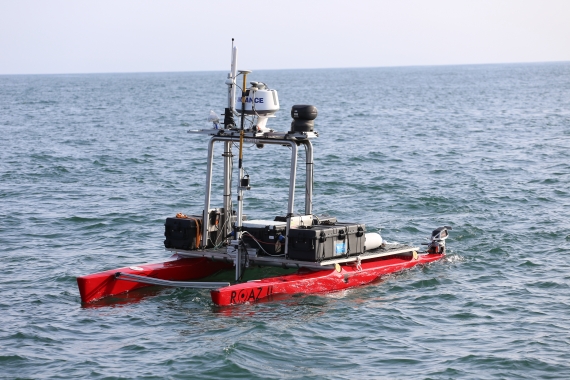Activities
ROAZ II
Autonomous Surface Vehicle (ASV)
Description
ROAZ II is an
Autonomous Surface Vehicle (ASV), which has been developed by INESC TEC and the Autonomous Systems
Laboratory (LSA) of the School of Engineering of the Polytechnic Institute of
Porto (ISEP). It is operating since 2008.
ROAZ II is equipped
with on-board sensor processing and high precision navigation, which enables it
to operate autonomously in the ocean environment. The robot has a wide range of
sensors and advanced on-board controls, allowing its use in efficient precision.
On-board ROV in coordinated missions makes it a suitable surface platform for
underwater inspection and data collection tasks.
ROAZ II is not a close
off-the-shelf system, and is continuously being adapted to different projects
and missions.
Specifications
General
- Vehicle type: Autonomous Surface Vehicle (ASV)
- Body shape: catamaran
- Body materials: Polyethylene and Aluminium
- Deployment: boat trailer or crane
- Length: 4.5 m
- Width: 2.2 m
- Weight: 400 kg
- Power: rechargeable batteries (LiFePO4, 4800 Wh)
- Battery charge time: 6 h
- Payload capacity: 300 kg
- Payload interfaces/ports: ethernet, serial RS232/485, CAN bus (IP68 or underwater connectors plugs)
Operation
- Autonomy: 10 h
- Range: 60-100 km
- Propulsion: two electric thrusters (independent)
- Propulsion power: 10 HP
- Maximum speed: 5 m/s (10 knots)
- Degrees of freedom: 3DOF
- Communications: Wi-Fi, RF, Iridium, underwater acoustic communications
- Navigation systems: RTK GPS, FOG INS, DVL, RADAR, LIDAR, visual and thermographic cameras
- Modes of operation: maned, teleoperation, autonomous waypoint following, station keeping and adaptive autonomous mission
Sensors
- Side-scan SONAR
- Multibeam Echosounder (MBES)
- Sub-Bottom Profiler (SBP)
- Video cameras (visible and thermographic)
- Sound velocity probe (SVP)
- DVL with ADCP option
Features
- Autonomous operation
- GPS with RTK and INS for precise positioning
- RADAR for obstacle detection
- Infra-red and visible light cameras
- On-board image processing
- Wireless communication (data/video)
- CTD
- Multi-beam sonar and side-scan sonar
- On-board inspection ROV (remotely operated vehicle)
Applications
- Aquatic environment monitoring
- Data collection and oceanography
- Environmental modelling (oceanographic, 3D sea floor modelling)
- Bathymetry
- Security
- Area patrol
- Automated intrusion detection
- Target identification and tracking
- Search and rescue
- Communications relay in multi-vehicle scenarios and surface support to underwater assets
